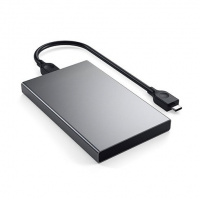External storage
More often referred to as an external drive, external storage is storage that is not part of the internal parts (external) of the computer. These drives often connect to a computer using a USB, eSATA or FireWire connection. Pictured is a Drobo example and an example of a popular external storage solution.
Examples of external storage devices
The following list contains external storage devices used during computer development. Click on any of these links to open more information about that external storage device.
Note
Some of the devices listed below may use an internal reader. For example, a floppy drive can be an internal drive that reads an external storage diskette. New computers that no longer support floppy drives could also use an external USB floppy drive, making the drive and floppy external.
Why is external storage used?
Below is a list of the benefits of using an external storage device with your computer.
An easy way to add more storage or options to your computer without opening up your computer.
With an external hard drive, you can store a lot of data for backup or to move between computers.
An external disk drive allows a computer without a disk drive to read CDs, DVDs, or other disks.
Devices like Drobo can give your computer additional features, such as RAID, to help protect your data.
An easy way to transfer files from one computer to another using sneakernet.
How do you access external storage?
Once connected, external storage is treated the same as internal storage (eg a hard drive) on your computer. For example, if you connect a USB stick to a computer, it will appear as a new drive letter in Explorer. If another F: drive letter was available, the F: drive should appear in Explorer. Once displayed, you can double-click the drive letter to open and view the files on the drive.
External storage vs. remote storage
Although remote storage is external, it should not be confused with external storage. Remote storage is accessed over a network and is often far away from the computer. For example, an office may have a network-attached storage (NAS) in a server cabinet that can be accessed and used by any computer on the network. See our remote storage page for more information.

